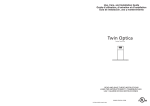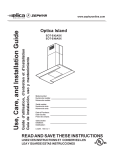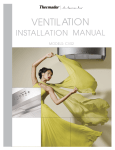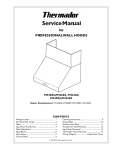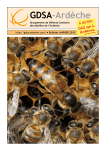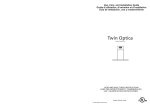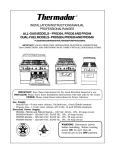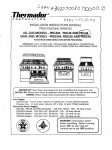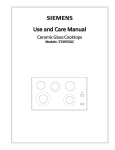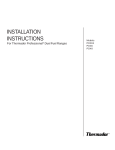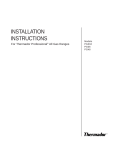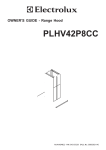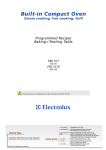Download Thermador HS-HST-HSB Ventilation Hood User Manual
Transcript
INSTALLATION INSTRUCTIONS HS-HST-HSB WALL HOODS APPROVED FOR RESIDENTIAL APPLIANCES FOR RESIDENTIAL USE ONLY PLEASE READ ENTIRE INSTRUCTIONS BEFORE PROCEEDING. INSTALLATION MUST COMPLY WITH ALL LOCAL CODES. IMPORTANT: Save these Instructions for the Local Electrical Inspectors use. INSTALLER: Please leave these Instructions with this unit for the owner. OWNER: Please retain these instructions for future reference. Safety Warning: Turn off power circuit at service panel and lock out panel, before wiring this appliance. Requirement: 120 V AC, 60 Hz. 15 or 20 A Branch Circuit READ AND SAVE THESE INSTRUCTIONS IMPORTANT SAFETY INSTRUCTIONS ciation (NFPA), the American Society for Heating, Refrigeration and Air Conditioning Engineers (ASHRAE), and the local code authorities. CAUTION: FOR GENERAL VENTILATING USE ONLY. DO NOT USE TO EXHAUST HAZARDOUS OR EXPLOSIVE MATERIALS OR VAPORS. WARNING - TO REDUCE THE RISK OF FIRE, ELECTRIC SHOCK, OR INJURY TO PERSONS, OBSERVE THE FOLLOWING: A. Use this unit only in the manner intended by the manufacturer. If you have questions, contact the manufacturer (Thermador Customer Service at 800/ 735.4328). B. Before servicing or cleaning the unit, switch power off at service panel and lock service panel disconnecting means to prevent power from being switched on accidentally. When the service disconnecting means cannot be locked, securely fasten a prominent warning device, such as a tag, to the service panel. C. Installation Work and Electrical Wiring Must Be Done By Qualified Person(s) In Accordance With All Applicable Codes & Standards, Including Firerated Construction. D. Sufficient air is needed for proper combustion and exhausting of gases through the flue (chimney) of fuel burning equipment to prevent backdrafting. Follow the heating equipment manufacturers guideline and safety standards such as those published by the National Fire Protection Asso- E. When cutting or drilling into wall or ceiling, do not damage electrical wiring and other hidden utilities. F. Ducted systems must always be vented to the outdoors. CAUTION: To reduce risk of fire and to properly exhaust air, be sure to duct air outside - do not vent exhaust air into spaces within walls, ceilings, attics, crawl spaces, or garages. WARNING - TO REDUCE THE RISK OF FIRE, USE ONLY METAL DUCT WORK. Install this hood in accordance with all requirements specified. WARNING - To Reduce The Risk Of Fire Or Electric Shock, Do Not Use This Hood With Any External Control Device. CAUTION: To Reduce The Risk Of Fire And Electric Shock, Install This Rangehood Only With Blower Models specified. Page 2 IMPORTANT SAFETY INSTRUCTIONS WARNING - TO REDUCE THE RISK OF A RANGE TOP GREASE FIRE. a) Never leave surface units unattended at high settings. Boilovers cause smoking and greasy spillovers that may ignite. Heat oils slowly on low or medium settings. b) Always turn hood ON when cooking at high heat or when flambeing food (i.e. Crepes Suzette, Cherries Jubilee, Peppercorn Beef Flambee). c) Clean ventilating fans frequently. Grease should not be allowed to accumulate on fan or filter. d) Use proper pan size. Always use cookware appropriate for the size of the surface element. WARNING - TO REDUCE THE RISK OF INJURY TO PERSONS, IN THE EVENT OF A RANGE TOP GREASE FIRE, OBSERVE THE FOLLOWING: a) SMOTHER FLAMES with a close-fitting lid, cookie sheet, or other metal tray, then turn off the gas burner or the electric element. BE CAREFUL TO PREVENT BURNS. If the flames do not go out immediately, EVACUATE AND CALL THE FIRE DEPARTMENT. b) NEVER PICK UP A FLAMING PAN - you may be burned. c) DO NOT USE WATER, including wet dishcloths or towels - a violent steam explosion may result. d) Use an extinguisher ONLY if: 1) You know you have a class ABC extinguisher, and you already know how to operate it. 2) The fire is small and contained in the area where it started. 3) The fire department is being called. 4) You can fight the fire with your back to an exit. Page 3 LES INSTRUCTIONS DE SÉCURITÉ IMPORTANTES ATTENTION: SEULEMENT POUR L’UTILISATION D’AÉRATION. NE PAS L’UTILISER POUR ÉPUISER LA VAPEUR OU LES MATIÈRES EXPLOSIVES OU DANGEREUSES. AVERTISSEMENT - POUR RÉDUIRE LE RISQUE D’INCENDIE, DE CHOC ÉLECTRIQUE, OU DE LA BLESSURE AUX PERSONNES, OBSERVER LE SUIVANT: A. Utiliser cet appareil seulement dans la manière destinée par le fabricant. Si vous avez des questions, contacter le fabricant. B. Avant lentretien ou le nettoyage de lappareil, couper le courant au tableau de service, et fermer à clef la moyenne de débrayage de service pour empêcher lalimentation dêtre allumée par hasard. Quand la moyenne de débrayage de service ne peut pas être fermée à clef, attacher une étiquette au tableau de service pour indiquer que l'alimentation a été coupée pour l'entretien. C. Le Travail dInstallation et de Câblage Électrique Doit Être Fait Par les Personne(s) Qualifiées Conformément à Tous les Codes & Normes Applicables, y Compris la Construction Calculée à Feu. appareil. Suivre la directive des fabricants du matériel chauffant et les normes de sécurité tel que ceux publiées par lAssociation du Protection de Feu National (NFPA), et la Société Américaine pour les Ingénieurs de Chauffage, de Réfrigération et de Climatisation (ASHRAE), et les autorités des codes locales. E. En coupant ou en forant dans un mur ou dans un plafond, ne pas endommager le câblage électrique et des autres utilités cachées. F. Les ventilateurs canalisés doivent être toujours déchargés à lextérieur. ATTENTION: Pour réduire le risque d’incendie, utiliser seulement le travail du conduit métallique. Installer ce capot conformé- ment aux toutes exigences spécifiées par le fabricant de votre cooktop/ cuisinière. ATTENTION: Pour réduire le risque d’incendie, de choc électrique, ne pas utiliser cette hotte avec aucun dispositif de contrôle exterieur. ATTENTION: Pour réduire le risque dincendie, de choc électrique, installer cette hotte seulement avec des modeles des moteurs indiqués. D. Lécoulement comburant pour le fonctionnement sûr du matériel de la combustion du combustible peut être affecté par le fonctionnement de cet Page 4 LES INSTRUCTIONS DE SÉCURITÉ IMPORTANTES AVERTISSEMENT - POUR RÉDUIRE LE RISQUE D’UN FEU DE GRAISSE DU SOMMET DE LA CUISINIÈRE: 1. Garder le ventilateur, les filtres et les surfaces chargées de la graisse propres. 2. Toujours mettre le capot EN MARCHE en cuisinant à la haute chaleur. 3. Utiliser les hauts positionnements du cuisinière sur la cuisinière seulement quand cest nécessaire. Chauffer lhuile lentement sur un positionnement bas àmoyen. 4. Ne pas laisser la cuisinière sans surveillance pendant la cuisson. 5. Utiliser toujours les batteries de cuisine et les ustensiles appropriés pour le type et la quantité de la nourriture ayant préparée. AVERTISSEMENT: - POUR RÉDUIRE LE RISQUE DE BLESSURE AUX PERSONNES DANS L’ÉVÉNEMENT D’UN FEU DE GRAISSE DU SOMMET DE LA CUISINIÈRE, OBSERVER LES SUIVANTS: a) ÉTOUFFER LES FLAMMES avec un couvercle ajusté, une tôle du biscuit ou un plateau métallique, puis fermer le bec. SOYEZ CERTAIN DEMPÊCHER LES BRÛLURES. Si les flammes ne séteindront pas immédiatement, ÉVACUER ET APPELER LE SERVICE DES INCENDIES. b) NE JAMAIS RAMASSER UNE CASSEROLE EN FLAMMES Vous pouvez être brûlé. c) NE PAS UTILISER DE LEAU, y compris les torchons mouillés ou les serviettes - une explosion violente résultera. d) Utiliser un extincteur SEULEMENT si: 1) Vous savez que vous avez un extincteur de Classe ABC et vous. savez déjà comment le faire fonctionner. 2) Le feu est petit et est contenu dans la région où il a commencé. 3) Le service des incendies est appelé. 4) Vous pouvez combattre le feu avec votre dos à une sortie. Page 5 Parts Included with your Hood • Hood Canopy Assembly with Light Bulbs Installed Care & Use /Installation Instructions Registration Card Filters, 2, 3 or 4 depending on model and size Metal Transition with Back draft dampers installed (On HST Series hoods it is temporarily fixed for shipping inside the hood with two screws) Screws and Drywall Anchors Remote Blower (pigtail) Adaptor (HS and HST Series hoods only) Wooden Strip for Hood Support (HST Series hoods only) Mounting Hooks Wire Clamp (HS and HST Series hoods only) Side mould (HSB30 and HS30 Series hoods only) Contents Sheet Parts Not Included with your Hood Page 6 Duct Tape 1/2" Conduit Wire Nuts Ventilator- The HS and HST series Hoods can be installed with any Thermador VTR600R, VTR1000Q, VTN420B or VTN620B Blower Optional duct cover, 6 or 12 height (HSB and HS Series hoods only) Optional telescopic duct cover (HST Series hoods only). IR Lamp (Purchase and use only lamps mod. 175R-PAR, 175W maximum infrared bulbs). Recirculating kit (HSB and HS Series hoods only) BEFORE INSTALLING HOOD 1. For the most efficient air flow exhaust, use a straight run or as few elbows as possible. CAUTION: Vent unit to outside of building, only. 2. Almost two people are necessary for installation. 3. The hood is fitted with Screws and Drywall Anchors suitable for most surfaces, consult a Qualified Installer, check if they perfectly fit with your cabinet/wall. 4. Do not use flex ducting. 5. COLD WEATHER installations should have an additional backdraft damper installed to minimize backward cold air flow and a nonmetallic thermal break to minimize conduction of outside temperatures as part of the ductwork. The damper should be on the cold air side of the thermal break. The break should be as close as possible to where the ducting enters the heated portion of the house. 6. Remote blowers require a five wire installation. 7. Make up air: Local building codes may require the use of Make-Up Air Systems when using Ducted Ventilation Systems greater than specified CFM of air movement. The specified CFM varies from locale to locale. Consult your HVAC professional for specific requirements in your area. Page 7 BEFORE INSTALLING HOOD APPLIANCE INSTALLATION CABINET OR SOFFIT PREPARATION Bottom of Cabinet or Soffit Cabinet 4-1/2" 12" Cabinet Front 1/2" (HS-HSB) Vertical Discharge A 9" 1/2" (HS-HSB) 5-7/8" 2-1/16" (HST) 4-3/8" 4-7/8" 1-7/8" 1-1/2" Dia. Holes 4-3/4" (HST) 20" Rear Wall Optional Rear Discharge Hood Width 12" Figure 1 Table 1 HOOD WIDTH DIM. "A" 30" 12 - 3/16" 36" 15 - 3/16" 42" 18 - 3/16" 48" 21 - 3/16" 4" HSB and HS Series Hoods 11" B HST Series Hoods 18" Table 2 HOOD DEPTH DIM. "B" 30" 22 - 11/16" 36" 23" 42" 23 - 5/16" 48" 23 - 7/8" B Figure 2 Note: It is important to select the ventilator to be used before cutting the duct opening on the cabinet or wall. Page 8 BEFORE INSTALLING HOOD TYPICAL INSTALLATION The hoods are designed for either vertical or horizontal discharge as shown in Figure A and B respectively. The height from the countertop to the bottom of the hood is 30" to 36”.These hoods are not recommended to be used over indoor grills. DUCTING Provide a Round Duct having a diameter of 8 (see Figure A and B for location and Figure 1 for location on wall or cabinet bottom). Install a 1/2 conduit from the service panel long enough to reach the hood once it is installed. Power supply must be rated for 120V 60Hz, 15 amps (minimum). Note - Horizontal Discharge: The Transition for this discharge direction is not supplied and must be purchased separately. Page 9 BEFORE INSTALLING HOOD Discharge Direction: The hood is shipped ready for horizontal discharge. To change to vertical discharge move plate to the rear side and ventilator (if supplied) to the top side. The plate and ventilator are held in place by four nuts each, see also Figures 3 and ,at page 9, Figure A and Figure B. Read also paragraph Integral Ventilator Installation at pages 14-15 for further informations. Note: If an integral ventilator is already supplied (HSB series hoods only), remove it to allow installation of hood to the wall/cabinet. Assembly of the Transition: The transition supplied with the hood mounts to the top of the hood, Figure 4. 1. Fold outwards all six Tabs (HS and HSB series only). 2. Align mounting holes at base of transition with mounting holes on 1/2 flange located at the top of the hood. 3. Fasten transition to hood using 6 (4 mm x 9.5 mm) screws (included with hood). 4. Duct tape connection between transition and hood. 5. Remove tape holding damper plate fixing point Plate Figure 3 Tab Tongue Transition Top outlet Figure 4 Page 10 BEFORE INSTALLING HOOD closed. HOOD WIDTH DIM. "W" DIM. "K" DIM. "Z" Wall Mount Installation 30" 29 - 1/8" 2 - 1/2" 7 - 1/16" HS and HSB series only. 36" 35 - 1/16" 2 - 1/2" 7 - 1/16" (see Figure 5) 42" 41 - 1/16" 2 - 1/2" 7 - 1/16" 1. After the hood installation height 48" 47 - 1/16" 2 - 1/2" 7 - 1/16" has been determined draw a horizontal line at a distance Table 3 above the cooktop equal to the desired hood installation height Side slot Transition plus 7- 1/2”. for cabinet bottom mount. 2. Find the centerline of the Top cooktop. Draw a vertical line screw location along this centerline up to Top Z the horizontal line drawn in outlet K W step 1 and draw a vertica Knockouts l i n e r i g h t a n d l e f t a t a (junction box) distance of 12-5/8” to determine the mounting 6" 3/1 5 location of the mounting Top 2 Square slot hooks shipped with the hood. screw location 3. Fit two mounting hooks on bottom mounting 7 1/2" screws locations the wall to hang the hood through the provided slots (2 wall anchors+2 hooks + 2 screws 5x45). 4. Run 8 Duct, long enough to reach the transition once the hood has been installed plus 1 1/2 inch to connect ductwork. Fix Duct to transition with screws and seal with tape. W 5. If mounted, remove the CL grease filter. Z 6. Remove 1 of 2 knockouts and K install 1/2 conduit connector in j-box. Hook for wall Screw for installation cabinet 7. Hang the hood and adjust its 25 3/16" bottom position through the screws installation 12 5/8" 12 5/8" on the hooks. Adjusting 7 1/2" screw 8. Fix the hood to 4 additional CL Bottom of the Hood point,2 on upper side, 2 on lower side (use 4 wall anchors Figure 5 + 4 washers + 4 screws 5x35. Page 11 Wall Mount Installation HST series Hood only (see Figure 6-7-8) 1. Hood Installation Height After the hood installation height has been determined draw a horizontal line at a distance above the cooktop equal to the desired hood installation height plus 16 1/2. This line is the mounting location of the wooden bracket shipped with the hood. 2. Find the centerline of the cooktop. Draw a vertical line along this centerline up to the horizontal line drawn in step 1. 3. The HST series hoods are mounted to the wall using a wooden bracket shipped with the hood. Remove the bracket from the hood by removing two shipping screws. Mark the centerline of the bracket. 6 Figure 6 4. Find studs behind the drywall by tapping the wall or using a stud finder. Locate one stud on either side of the cooktop centerline to use for mounting the wooden bracket as shown in Figure 6. 5. Align the top of the wood bracket along the horizontal line drawn in step 1. Align the centerlines of the bracket and cooktop. 6 7/8 6. Drill a 3 deep 1/8 tap hole through the wooden bracket, drywall, and into the stud. 7. Use 2-4 (6mm x 80 mm) screws to attach the bracket to the wall as shown in Figure 7. For support of longer hoods, use Figure 7 Page 12 three or four studs as available. Countersink the heads to prevent interference with the hood. 8. On the wood bracket mark the locations used to hang the hood according to Figure 7. 9. Drill a 1/8 tap hole through the wooden bracket and drywall. These screws do not need to go into the studs. 10.Screw 2 (4.2mm x 18 mm) screws into the wood bracket leaving 1/4 of the screw exposed for hanging the hood. 11.Discharge Direction: Horizontal discharge requires a wall cutout, as shown in Figure 1 of this manual, to provide clearance for the transition. The location of the cutout is determined by the hood installation height. For Vertical discharge,please refer to step 4, Page 10. J I K Figure 8 12.Hang the hood using slots I in Figure 8. Make sure the wood bracket fits into the recess on the back of the hood. 13.Tighten the screws in slots I. Use slots I to level the hood. 14.From inside the hood drive 4 or 6 screws depending on model (4.2 mm x 18 mm) through holes J into wooden bracket. 15. Drill a 3/8 tap hole through the center of the holes K into the wall. Insert two wall plugs into drilled holes. Tighten hood to wall anchors by installing 2 screws with washers. Page 13 Cabinet Installation: (Figure 5) Note: distances on page 10, Table 3. INTEGRAL VENTILATOR INSTALLATION (Models VTN420B or VTN620B) (see figure 9) 1. Find the centerline of the cabinet bottom. Draw a line along this centerline from rear to front of the cabinet. 2. Draw two lines, one at a K distance from the wall, the other one at a Z distance from the previous line. Mark 4 points , two along each line at a distance of half W from the center line, to determine the screw locations. 3. Fit 4 screws on cabinet bottom do not tighten completely but leave a space of about 1/2 from cabinet bottom surface and head screws. 4. Run 8 Duct, long enough to reach the transition once the hood has been installed plus 1 1/2 inch for connect ductwork. Fix Duct to transition with screws and seal with tape. 5. If mounted, remove the grease filter. 6. Remove 1 of 2 knockouts and install 1/2 conduit connector in j-box. 7. Hang the hood on screws through side slots provided on hood top. Tighten the four screws. If possible fix the hood on the wall at 4 additional point (2 on upper side, 2 on lower side). The Integral ventilator can be mounted to discharge air as shown on figure A and B at page 9. It must be fixed through the slots of the ventilator and pins with nuts of the hood. Tighten all four nuts. Integral ventilator fixing point Motor support bracket Figure 9 Page 14 Motor connector From Control Panel Wiring the HOOD with an IntegralVentilator: Warning: Turn off electricity at the service panel before wiring the unit. 1. Connect the Integral Ventilator molex plug connector to the connector present inside the hood as shown in Figure 9 or Figure 10. 2. Remove the j-box cover as shown in Figure 11. 3. Remove 1 of 2 knockouts and install 1/2 conduit connector in j-box. 4. Run black, white, and green wires (#14 AWG) in 1/2 conduit from power supply to j-box. 5. Connect black, white, and green wires from power supply to black, white, and green/ yellow wires in j-box respectively. 6. Close j-box cover. Final installation steps 7. Only HSB30 and HS30 Series hoods: fit the side mould on the right side, and fix it with 3 screws as shown in Figure 12. 8. Replace filters as described in the Care & Use section of this manual. Turn power on at service panel. Check operation of the hood. Figure 10 From control panel Figure 11 Figure 12 Page 15 Motor connector VTN 420 or VTN 620 REMOTE VENTILATOR INSTALLATION Models VTR600R or VTR1000Q (Only HS and HST Series Hood): The hood is designed to work with Thermadors remote ventilator (see list under paragraph Parts Not Included with your Hood). For installation instructions see the instructions supplied with the ventilator unit. respectively. Connect the remote blower green/yellow (ground) wire to the ground wire from the service panel. 9. Close junction box cover. Check that all light bulbs are secure in their sockets. Install filters. Turn power on at service panel, and check lights and blower operation per Care & Use section of this manual. Wiring the Hood with a Remote Ventilator: Warning: Turn off electricity at the service panel before wiring the unit. 1. Remove the j-box cover as shown in Figure 13. 2. Remove cover T from the j-box. 3. Remove the 2 knockouts and install 1/2 conduit connectors. 4. Run black, white, and green wires (#14AWG) in 1/2 conduit from power supply to j-box. 5. Connect black, white, and green wires from power supply to black, white, and green/ yellow wires in j-box respectively. 6. Connect wire clamp to pigtail as shown in Figure 12. Insert pigtail wires into j-box and fix wire clamp to j-box using nut supplied with wire clamp V. 7. Run five wires (#14 AWG) in 1/ 2 conduit from the remote blower to the second conduit connector. 8. Connect the black, white, red, and blue wires from the remote ventilator to the black, white, red, and blue wires of the pigtail Ground Figure 13 Page 16 Assembly and Installation of the Duct Covers (HS and HSB Series Hood only): Optional duct covers shown in Figure 14 may be used to fill the space between the hood and ceiling in wall mount installations. 6 and 12 high duct covers are available and may be ordered separately. 1. If multiple duct covers are used, connect the pieces together using sheetmetal screws provided with chimneys. Fixing Screws (number depends on hood size) 2. Attach the duct cover(s) to the hood using sheetmetal screws as shown in Figure 14. Figure 14 Page 17

















